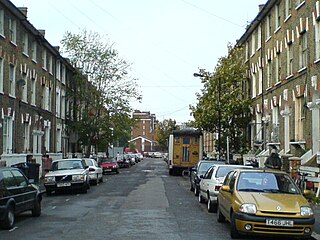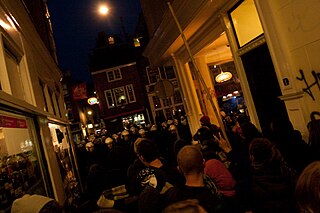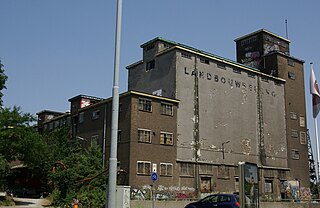
Squatting is the action of occupying an abandoned or unoccupied area of land or a building, usually residential, that the squatter does not own, rent or otherwise have lawful permission to use. The United Nations estimated in 2003 that there were one billion slum residents and squatters globally. Squatting occurs worldwide and tends to occur when people who are poor and homeless find empty buildings or land to occupy for housing. It has a long history, broken down by country below.

St Agnes Place was a squatted street in Kennington, south London, which resisted eviction orders for more than 30 years. When a number of derelict houses were scheduled for demolition to extend Kennington Park in 1969, squatters occupied the properties and a High Court injunction prevented the demolition. The street was run by a housing cooperative until 2005, when Lambeth London Borough Council obtained an eviction order. Demolition was completed in 2007.

The Poortgebouw is a national monument located at Stieltjesstraat 38 in the Kop van Zuid area of Rotterdam, the Netherlands. It was built beside the River Maas in 1879 and experienced a range of uses until it was squatted October 3, 1980. It had been standing empty for 2 years and was squatted as a protest intended to highlight the lack of affordable residential housing in Rotterdam.
The Frances Street Squats were a set of six squatted houses, including one women-only building, that existed between February and November 1990 in Vancouver, Canada. They were occupied by SAVE and took a stand against development which was generally supported by local people. The Vancouver Police Department evicted the buildings.

The Dutch squatting ban refers to the law introduced on 1 October 2010, under which squatting in the Netherlands became de jure illegal. Criminalization had first been proposed in the 1970s, but was opposed by the Council of Churches. In 2006, a new plan was proposed and backed by parties including VVD and PVV. When the new law was introduced, squatters occupied the former head office of the fire brigade and there were riots in Amsterdam and Nijmegen. In 2011, the Supreme Court of the Netherlands ruled that the legally forced end of squatting can only occur after an intervention of a judge. Between October 2010 and December 2014, 529 people were arrested for the act of occupying derelict buildings, in 213 separate incidents as a result of which 39 people were jailed.

In England and Wales, squatting—taking possession of land or an empty house the squatter does not own—occurs for a variety of reasons which include needing a home, protest, poverty, and recreation. Many squats are residential; some are also opened as social centres. Land may be occupied by New Age travellers or treesitters.

Argyle Street was a Victorian terraced street in Norwich, Norfolk. It became a squat lasting from 1979 to 1985. The street was then demolished in 1986. Some of the newbuild houses were subsequently demolished in 2015.

Squat Milada is a First Republic villa located in the Libeň district of Prague. Milada was intended to be demolished in the 1980s and thus deleted from the cadastre, becoming a house which officially did not exist. It became one of the Czech Republic's best known squats, occupied from 1997 until 2009. It was then reoccupied for a day in 2012. Acting as a self-managed social centre and infoshop hosting concerts and events, Milada was also home to a number of people. Despite various plans for the site, as of 2019, the building was standing derelict.

Landbouwbelang (LBB) is an industrial building in Maastricht, Netherlands. It offers working space for artists and social entrepreneurs and functions as a venue for cultural events. It has been squatted since April 2002.

The Vondelstraat riots were violent disturbances on Vondelstraat in Amsterdam, the Netherlands between squatters and the state in March 1980. It also involved the deployment of military tanks on the streets for the first time since World War II, and was one of the most serious disturbances involving squatters in the country.

Vrijplaats Koppenhinksteeg was a complex of buildings first squatted in 1968 in Leiden, the Netherlands. It took its name from the alley on which it was located and was run since the 1990s by the Vrijplaats Koppenhinksteeg Foundation. Various groups including Eurodusnie used the different spaces as a bar, café, a freeshop, a foundation to support undocumented migrants, an information centre, a library and a sports club. In 2010, the entire complex was evicted. From 2012 onwards a new space called the Vrijplaats Leiden was set up elsewhere.

Squatting in Australia usually refers to a person who is not the owner, taking possession of land or an empty house. In 19th century Australian history, a squatter was a settler who occupied a large tract of Aboriginal land in order to graze livestock. At first this was done illegally, later under licence from the Crown.

Squatting in the Republic of Ireland is the occupation of unused land or derelict buildings without the permission of the owner. In the 1960s, the Dublin Housing Action Committee highlighted the housing crisis by squatting buildings. From the 1990s onwards there have been occasional political squats such as Grangegorman.

We Are Here is a collective of migrants based in Amsterdam, the Netherlands, which campaigns for human rights for its members and all undocumented migrants. The asylum seekers have in many cases had their applications to remain in the Netherlands denied but they either cannot go back or refuse to return to their country of origin. They ask for access to social services such as medical care and housing. The group formed in 2012 and by 2015 contained over 200 migrants from around 15 countries.
The WNC squat was a self-managed social centre in Groningen, the Netherlands. It was squatted in 1985 and evicted in 1990.

Squatting in the Netherlands is the occupation of unused or derelict buildings or land without the permission of the owner. The modern squatters movement began in the 1960s in the Netherlands. By the 1980s, it had become a powerful anarchist social movement which regularly came into conflict with the state, particularly in Amsterdam with the Vondelstraat and coronation riots.

De Vloek was a squatted, self-managed social centre in The Hague, the Netherlands, between 2002 and 2015. Located on Hellingweg 127 in Scheveningen, beside the North Sea, the squat hosted workplaces, living spaces, a venue, and a vegan restaurant. The local council tolerated the occupation until 2014, when it decided to sell the building. A political struggle over the eviction began; some political parties supported the squatters and the Scheveningen Pier was briefly occupied as a protest action. A deal was made for the squatters to move to a former school building and the Vloek was eventually evicted in September 2015.
Huize Ivicke is a monumental building in Wassenaar, the Netherlands. Constructed in 1913 for A. F. J. van Hattum, it is a replica of the Eremitageslottet hunting lodge in the Jaegersborg Dyrehave in Denmark. It was inhabited until the mid-1980s, when it became offices. Since 2000, it has been owned by speculator Ronnie van de Putte, known as the "Slum King of the Netherlands". He refuses to renovate the building, despite its monumental status. Heritage groups warned the local municipality in the late 2010s that the villa was severely dilapidated and it was placed on a list of the fourteen most threatened monuments in Europe. It is currently the subject of an intense dispute over emergency renovations and was squatted in 2018, by people wanting to carry out essential repairs. The house, the formal garden, the gate and the playhouse are all national monuments.

The Piersonstraat riots occurred in 1981 in Nijmegen, the Netherlands. After the city council decided to demolish a warehouse and houses in the city centre to build a parking garage, local activists and the squatters movemment combined to resist the eviction. This resulted in riots and the events have become part of Dutch history. The parking garage was not built.
The modern political squatting movement began in Hamburg, Germany, when Neue Große Bergstraße 226 was occupied in 1970. Squatters wanted to provide housing for themselves amongst other demands such as preventing buildings from being demolished and finding space for cultural activities. The Hafenstraße buildings were first occupied in 1981 and were finally legalized after a long political struggle in 1995. The still extant Rote Flora self-managed social centre was occupied in 1989. Squatting actions continue into the present; more recent attempts are quickly evicted, although the Gängeviertel buildings were squatted and legalized in the 2010s.



















